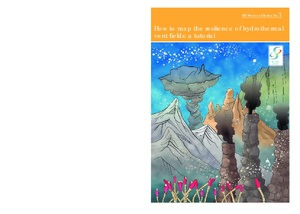| dc.date.accessioned | 2019-04-05T13:23:32Z | |
| dc.date.available | 2019-04-05T13:23:32Z | |
| dc.date.issued | 2019 | |
| dc.identifier.citation | Japan Agency for Marine-Earth Science and Technology (2019) How to map the resilience of hydrothermal vent fields: a tutorial. Version 1. Yokosuka-city, Kanagawa, Japan, Japan Agency for Marine-Earth Science and Technology (JAMSTEC), 21pp. (SIP Protocol Series No. 7). DOI: http://dx.doi.org/10.25607/OBP-445 | en_US |
| dc.identifier.uri | http://hdl.handle.net/11329/901 | |
| dc.identifier.uri | http://dx.doi.org/10.25607/OBP-445 | |
| dc.description.abstract | One of the targets for commercial mining is the Seafloor Massive Sulfides (SMSs) deposits
formed around hydrothermal vents, which is a highly attractive source of copper, zinc, lead,
gold and silver ores (Hoagland 2010, Herzig 1999, Binns and Scott 1993, Halbach et al. 1989).
Hydrothermal vents host chemosynthetic communities as well as metal rich ores. The
chemosynthetic communities consist of many endemic invertebrate species specifically
adapted to the vent environment via microbial chemoautotrophic primary production (Van
Dover 2010). These species have provided new scientific insights into the mechanisms by
which organisms adopt to the extreme environment (Jannasch and Wirsen 1979). Furthermore,
as reviewed by Le et al. (2016), ecological function and services of these communities range
from providing habitat and refuge for other species including non-endemic species (Levin et al.
2016, Govenar 2010), playing a key role in global carbon, sulfur and heavy metals cycling
(Jeanthon, 2000, D'Arcy and Amend 2013) and offering new biomolecules that could contribute
to industrial development (Terpe et al. 2013, Mahon et al. 2015).
Mining of seafloor massive sulfide deposits potentially changes the physico-chemical
environment of a vent community through the loss of sulfide habitat, degradation of sulfide
habitat quality, modification of fluid flux regimes and exposure of surrounding seafloor
habitats (including non-sulfide habitats) to sedimentation and heavy metal deposition
(International Seabed Authority 2007, Van Dover 2014). This will directly affect the ecological
community by removing and reclaiming organisms, reducing the amount of habitable substrate
and changing resource supply. Physico-chemical models and organism distribution data have
been integrated to estimate the potential area of sedimentation (Coffey Natural Systems
2008b). However, after the instantaneous effects of a disturbance, the ecological community
will reach a new equilibrium state within the disturbed environment (Ives and Carpenter 2007).
Hence, potential impacts of artificial disturbances, including how they may cause extinction
and modify community structure at different spatial scales (local, regional and global), and
decrease diversity at different biological levels (genetic, species and phylogenetic), will be
understood by considering both direct impacts of mining activities and subsequent ecological responses. Environmental impact assessments (EIAs) that lack this point of view might
severely underestimate the potential risks of anthropological activities. | en_US |
| dc.language.iso | en | en_US |
| dc.publisher | Japan Agency for Marine-Earth Science and Technology (JAMSTEC) | en_US |
| dc.relation.ispartofseries | SIP Protocol Series;7 | |
| dc.subject.other | Hydrothermal vents | en_US |
| dc.subject.other | Sulphide deposits | en_US |
| dc.subject.other | Mining effects | en_US |
| dc.subject.other | Hydrothermal communities | en_US |
| dc.title | How to map the resilience of hydrothermal vent fields: a tutorial. Verson 1. | en_US |
| dc.type | Report | en_US |
| dc.description.status | Published | en_US |
| dc.format.pages | 21pp. | en_US |
| dc.contributor.corpauthor | Japan Agency for Marine-Earth Science and Technology | en_US |
| dc.description.refereed | Refereed | en_US |
| dc.publisher.place | Yokosuka-city, Kanagawa, Japan | en_US |
| dc.subject.parameterDiscipline | Parameter Discipline::Marine geology | en_US |
| dc.subject.parameterDiscipline | Parameter Discipline::Chemical oceanography | en_US |
| dc.subject.parameterDiscipline | Parameter Discipline::Biological oceanography | en_US |
| dc.description.currentstatus | Current | en_US |
| dc.description.bptype | Best Practice | en_US |
| dc.description.bptype | Standard Operating Procedure | en_US |
| obps.contact.contactname | Masanobu Kawachi | |
| obps.contact.contactemail | kawachi.masanobu@nies.go.jp | |
| obps.resourceurl.publisher | https://www.jamstec.go.jp/sip/resultList.html | en_US |
 Repository of community practices in Ocean Research, Applications and Data/Information Management
Repository of community practices in Ocean Research, Applications and Data/Information Management
